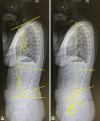Factors Associated with Neck and Shoulder Pain in Volunteers
- PMID: 31440666
- PMCID: PMC6698530
- DOI: 10.22603/ssrr.2017-0079
Factors Associated with Neck and Shoulder Pain in Volunteers
Abstract
Introduction: The aims of the present study were 1) to examine the association between neck and shoulder pain (NSP) and lifestyle in the general population and 2) to examine if sagittal spino-pelvic malalignment is more prevalent in NSP.
Methods: A total of 107 volunteers (mean age, 64.5 years) were recruited in this study from listings of resident registrations in Kihoku region, Wakayama, Japan. Feeling pain or stiffness in the neck or shoulders was defined as an NSP. The items studied were: 1) the existence or lack of NSP and their severity (using VAS scale), 2) Short Form-36 (SF-36), 3) Self-Rating Questionnaire for Depression (SRQ-D), 4) Pain Catastrophizing Scale (PCS), 5) a detailed history consisting of 5 domains as being relevant to the psychosocial situation of patients with chronic pain, 6) A VAS of pain and numbness to the arm, and from thoracic region to legs. The radiographic parameters evaluated were also measured. Participants with a VAS score of 40 mm or higher and less were divided into 2 groups. Association of SF-36, SRQ-D, and PCS with NSP were assessed using multiple regression analysis.
Results: In terms of QoL, psychological assessment and a detailed history, bodily pain in SF-36, SRQ-D, and family stress were significantly associated with NSP. A VAS of pain and numbness to the arm, and from thoracic region to legs, was significantly associated with NSP. There were no statistical correlations between the VAS and radiographic parameters of the cervical spine. Among the whole spine sagittal measurements, multiple logistic regression analysis showed that sacral slope (SS) and sagittal vertical axis (SVA) were significantly associated with NSP.
Conclusion: In this study, we showed the factors associated with NSP. Large SS and reduced SVA were significantly associated with NSP, while cervical spine measurements were not.
Keywords: cervical sagittal vertical axis; cervical spine; lifestyle; neck and shoulder pain; sacral slope; sagittal spino-pelvic alignment.
Conflict of interest statement
Conflicts of Interest: No funds were received in support of this work. No benefits in any form have been or will be received from a commercial party related directly or indirectly to the subject of this manuscript.
Figures




References
-
- Côté P, Cassidy JD, Carroll L. The factors associated with neck pain and its related disability in the Saskatchewan population. Spine. 2000;25(9):1109-17. - PubMed
-
- Statistics and Information Department, Ministry of Health, Labour and Welfare. Comprehensive survey of living condition of the people on health and welfare 2010. Tokyo: Ministry of Health, Labour and Welfare; PUB DATE [updated DATE; cited 2013 Jul 12]. Available from: http://www.mhlw.go.jp/toukei/saikin/hw/k-tyosa/k-tyosa10
-
- Iizuka Y, Shinozaki T, Kobayashi T, et al. Characteristics of neck and shoulder pain (called katakori in Japanese) among members of the nursing staff. J Orthop Sci. 2012;17(1):46-50. - PubMed
-
- Jackson RP, McManus AC. Radiographic analysis of sagittal plane alignment and balance in standing volunteers and patients with low back pain matched for age, sex, and size. A prospective controlled clinical study. Spine (Phila Pa 1976). 1994;19(14):1611-8. - PubMed
LinkOut - more resources
Full Text Sources
